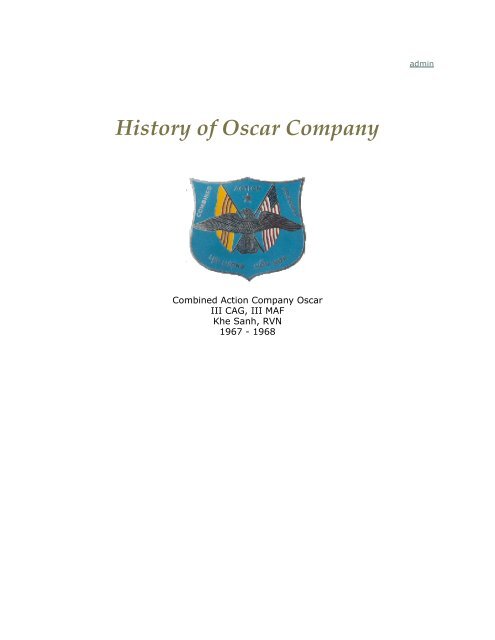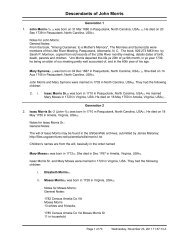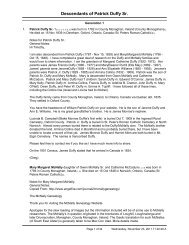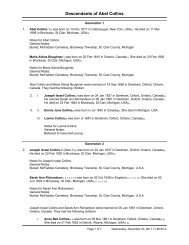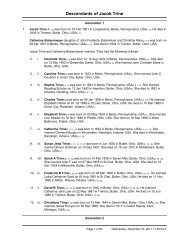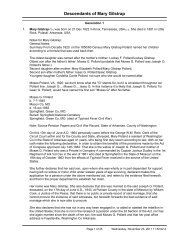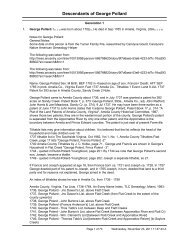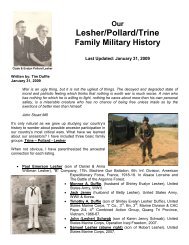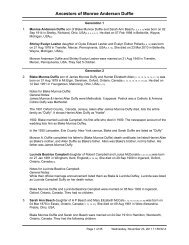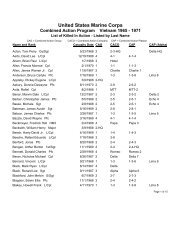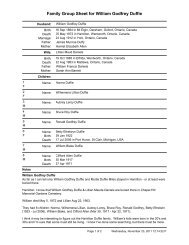History of Oscar Company - USMC Combined Action Platoon ...
History of Oscar Company - USMC Combined Action Platoon ...
History of Oscar Company - USMC Combined Action Platoon ...
Create successful ePaper yourself
Turn your PDF publications into a flip-book with our unique Google optimized e-Paper software.
<strong>History</strong> <strong>of</strong> <strong>Oscar</strong> <strong>Company</strong><br />
<strong>Combined</strong> <strong>Action</strong> <strong>Company</strong> <strong>Oscar</strong><br />
III CAG, III MAF<br />
Khe Sanh, RVN<br />
1967 - 1968<br />
admin
(Courtesy <strong>of</strong> HN "Doc" John Roberts, O-2)<br />
A rare photo (perhaps the only one extant) <strong>of</strong> an entire <strong>Combined</strong> <strong>Action</strong><br />
<strong>Company</strong> all together. (You can help by identifying yourself and your friends!) I<br />
am on the front row, extreme right, kneeling with M-16, helmet, and flak jacket.<br />
Doc Roberts is top row, second from the right, minus helmet, with glasses.) This<br />
photo was taken by a Bru with Doc Roberts' camera just before the big sweep<br />
made in October 1967. (See below)<br />
----<br />
As noted in the Introduction, this history is only an outline. It is told mainly from<br />
my own memories, and those <strong>of</strong> a handful <strong>of</strong> other <strong>Oscar</strong> company men, as well<br />
as <strong>of</strong>ficial records. Unfortunately, my memory is not what it used to be, and I was<br />
not present for all the events recounted here. Therefore, there is much that needs<br />
to be written that I cannot write alone. I hope that all <strong>of</strong> you who were there will<br />
help fill in the details.<br />
There will be a more complete version available to members in the near future. I<br />
will also be putting personal recollections in the section entitled "In Their Own<br />
Words" (Beneath this heading on the left sidebar menu). You may E-mail these to<br />
me, write, call, or send a tape cassette or CD with your stories, or add them to<br />
the comments page on this site. I will edit them for you if desired. My personal<br />
first choice would be either E-mail or submitted as comments via this site - that<br />
way, they are already digitized. However, I will accept calls, tapes, letters (if<br />
legible!) etc., if necessary.
NOTE: Since some <strong>of</strong> the events in this narrative occurred before or after my tour,<br />
or while I was hospitalized, I can only vouch for the verity <strong>of</strong> those events I<br />
actually witnessed and participated in. Even then, one's own subjective<br />
experience and perception <strong>of</strong> events can vary greatly from another person's. Also,<br />
some <strong>of</strong> the things were written at or near the time they occurred, others years<br />
later - and memory can be deceitful!<br />
Events I did not participate in directly are compiled from a number <strong>of</strong> sources -<br />
<strong>of</strong>ficial records where available, and oral or written accounts from participants,<br />
both contemporary and later.<br />
The <strong>of</strong>ficial records are <strong>of</strong>ten subject to the usual errata and / or "<strong>of</strong>ficial" point <strong>of</strong><br />
view, and the personal statements were, like mine, sometimes made years later,<br />
and in any case, are colored by the individual's experience, perception, and<br />
memory.<br />
However, despite these caveats, this is as truthful and accurate an account as I<br />
am able to present, and one that has rarely been presented. In truth, it is long<br />
overdue, because except for Ray Stubbe and a few others, this chapter <strong>of</strong> history<br />
has been almost completely ignored.<br />
Foundation<br />
In February 1967, the Narrative Summary <strong>of</strong> the HQ 3rd MarDiv (Rein) notes the<br />
establishment <strong>of</strong> Sub Unit # 5 at Khe Sanh. This date corresponds to the<br />
establishment <strong>of</strong> <strong>Oscar</strong> <strong>Company</strong>.<br />
The company eventually consisted <strong>of</strong> the HQ unit and 3 CAPs. HQ was combined<br />
with CAP <strong>Oscar</strong> 1 in "downtown" Khe Sanh village. HQ and O-1 formed a "double<br />
CAP" - 2 CAP plts + 2 Plts <strong>of</strong> the 915th Regional Force Co. (RVN). There were also<br />
4 US Army advisors for a total <strong>of</strong> approx. 178 men.<br />
Outlying units were <strong>Oscar</strong> 2, on the north side <strong>of</strong> Hwy. 9 at the western end <strong>of</strong> the<br />
village, and CAP <strong>Oscar</strong> 3, assigned to Ta Cong Village in Khe Sanh Valley. (This<br />
CAP was originally located on the South side <strong>of</strong> QL-9 appx 800 meters south <strong>of</strong><br />
the west end <strong>of</strong> the main Khe Sahn Airfield.)<br />
Originally, the unit seems to have been commanded by a sergeant, whose name I<br />
have been unable to find. 1st LT (later CPT) William T. Sermeus arrived to take<br />
command sometime in February 1967. (see In Memoriam ) He was in command<br />
when the late Raymond Gray arrived in February 1967. 1st LT Sermeus picked<br />
him up, along with two men whom Ray described as "CIA" at KSCB. They rode in<br />
a Mighty Mite, (M422/A1, a field utility vehicle somewhat like a jeep). They visited<br />
CAP O-3, en route to CAP O-1.<br />
An Early Tragedy
LT Sermeus and Ray later traveled back to O-3, where the LT issued orders to<br />
clear a "friendly" mine field. The NCOIC complied, though with serious<br />
reservations, as there was no map <strong>of</strong> the field.<br />
On June 14th, CPL Albers (see In Memoriam ) lost both legs removing mines. Ray<br />
said that the word came while LT Sermeus was out on patrol with them. LT<br />
Sermeus was described as being "terribly shaken" by the news. Ray described the<br />
sergeant at O-3 as extremely distraught as he had been close to the man.<br />
(According to the <strong>of</strong>ficial reports, there was another man injured as well, but I<br />
cannot find a record <strong>of</strong> him, or his name. Does anyone have that information?)<br />
Back to Top<br />
CAP O-3 Loses a Patrol<br />
There was an NVA rocket and mortar attack on the base just after midnight on<br />
June 27th, 1967. A patrol from O-3 was sent to investigate suspected rocket and<br />
mortar launch sites spotted by observers. The patrol members included LCPL<br />
Francisco Alberto Mazariegos, CPL Dennis Alfred O'Connor, CPL James Merrill<br />
Shepard, Jr., and LCPL Charles Aaron Lynch <strong>of</strong> <strong>Oscar</strong>-1, who was along because<br />
he had been visiting his friends at O-3.<br />
They launched at 0830, and about 1230 had reached the top <strong>of</strong> Hill 689, where<br />
they were ambushed, receiving heavy enemy fire, including rockets and automatic<br />
weapons. They immediately sustained casualties, some hit trying to reach<br />
comrades. An artillery mission was called in, but was nearly on top <strong>of</strong> their<br />
position. The survivors were unable to reach the KIA and wounded, except for one<br />
WIA who died en route to the camp. After the artillery fire, two men attempted to<br />
sweep the hill for friendly WIA and KIA, but were driven back. The remains <strong>of</strong> the<br />
patrol were forced to retreat, leaving two Marines and one Bru PF on the hill,<br />
status MIA. The survivors fell back to their compound, where elements <strong>of</strong> the<br />
other CAPs were mustering.<br />
A rescue force was almost immediately mounted by the remainder <strong>of</strong> CAP-3 and<br />
the other CAPs, who had just completed a grueling patrol, but was repulsed by<br />
the NVA, who were apparently well dug in and in force. India and Lima company<br />
3/26 came to relieve CAP and try to dislodge the enemy. They assaulted the hill,<br />
and lost a number <strong>of</strong> <strong>of</strong>ficers, NCOs and enlisted men incl. Lima CO CAPT Bynum<br />
and LT Allen <strong>of</strong> India's First <strong>Platoon</strong>, all KIA, and a substantial number <strong>of</strong> WIA.<br />
Although they eventually gained the hill, It took several days and a ferocious air<br />
and artillery barrage to shift the determined enemy.<br />
Back to Top<br />
LT Sermeus was replaced by (I believe) CPT Haines (does anyone know his full<br />
name and the time frame? I am working on getting the chronology right), who<br />
was in turn replaced by 1stLT Ernest Elmore. (Again, does anyone know the time<br />
frame?)
During this period, things were relatively quiet after the ambush, despite the<br />
build-up that was going on in the area. Patrols, LPs (listening posts) and<br />
ambushes were being run, and some contact was made.<br />
I arrived at O-2 in late September <strong>of</strong> 1967, and found things were rather calmer<br />
than I had expected them to be. I was new to scouting and patrolling, having<br />
been assigned as an admin man and later (briefly) to FDC with HQ 3/12, but I<br />
remembered the basic infantry concepts and the men who had been there were<br />
quick to teach me the ropes. In our unit, CPL Joe Potter and others gave me<br />
valuable training on how to operate in the bush.<br />
Back to Top<br />
Weapons and Equipment<br />
Of course, as the FNG, I got to hump the radio. As I recall, these were mostly the<br />
older PRC-10s, which were fairly useless unless you were in line <strong>of</strong> sight <strong>of</strong> a<br />
tower or relay, or on top <strong>of</strong> a hill. They were old, cranky, heavy, and much <strong>of</strong> the<br />
time they were malfunctioning.<br />
We were originally armed with the M-14, but we soon received the M-16. I had a<br />
very worn XM16E1. (I have since been told that the X stands for "experimental -<br />
this would have been a protoype model. How and why it was in the field in<br />
combat is beyond my comprehension.)<br />
I was very sorry to lose my M-14, because despite the weight, it always<br />
functioned. The M-16 was very subject to jamming, especially the old pieces <strong>of</strong><br />
junk we were issued. Most <strong>of</strong> us were in the habit <strong>of</strong> taping an assembled bore<br />
punch (cleaning) rod to the side <strong>of</strong> the stock to facilitate clearing the jams.<br />
I have had this discussion with many troops, Marine and Army, and although<br />
some tolerated or even liked the weapon, the bulk <strong>of</strong> the men I knew who used<br />
them in combat didn't. The ones who did were usually armed with the newer<br />
"improved" versions, which had addressed at least some <strong>of</strong> the malfunction issues<br />
the weapon had.<br />
I soon came to cordially and deeply hate mine, and "acquired" a .45 (with 4<br />
magazines) and a sack <strong>of</strong> grenades. At least I knew these would sustain me when<br />
the inevitable jam occurred.<br />
I think that I can say without fear <strong>of</strong> contradiction that the "pucker factor" - ever<br />
present in combat - is at an all-time peak when your weapons fail to function. (Of<br />
course, as one <strong>of</strong> Murphy's Laws <strong>of</strong> Combat remind us; "Never forget that your<br />
weapons were made by the lowest bidder.")<br />
I think the incident depicted below is a fairly typical example <strong>of</strong> a night combat<br />
encounter - <strong>of</strong>ten, both sides would come upon one another totally unaware -
which could lead to disastrous results. I recently spoke to a former CAP<br />
commander in another group who recounted an ambush that resulted in four US<br />
Army troops being killed - because the Army operational commander had earlier<br />
refused the CAP's request for well-defined operational areas and joint planning.<br />
Fortunately for us, there were no US patrols operating in our AOR the night <strong>of</strong> this<br />
encounter.)<br />
Back to Top<br />
Firefight Near O-2<br />
I was on point, and heard the enemy before they detected us. (I couldn't see<br />
anything - it was in part <strong>of</strong> the Poilane plantation to the southwest <strong>of</strong> our<br />
compound and as black as pitch. Fortunately, my hearing was much better in<br />
those days.)<br />
As I recall, LCPL Gullickson (aka "Gully") was leading the patrol, and he came<br />
quietly up as I halted the patrol. I indicated the apparent direction <strong>of</strong> the enemy.<br />
He nodded and prepared his favorite trick - an air burst with a grenade. Pulling<br />
the pin, he popped the spoon and held the thing for what seemed an interminable<br />
time - then he let fly. It burst in the area we believed them to be in, and we all<br />
opened up with everything we had. The enemy was apparently as surprised as we<br />
were, and may have been stunned and perhaps wounded by the airburst and<br />
heavy volume <strong>of</strong> fire. Theyreturned sporadic fire at first, but got their act together<br />
and soon were putting out a moderate volume <strong>of</strong> fire<br />
In a matter <strong>of</strong> minutes, ALL the M-16s had jammed - if the Bru hadn't been<br />
armed with M-1s and a BAR and I hadn't had my .45 and grenades, the enemy<br />
might have waxed us. However, the Bru quickly went through their meagre supply<br />
<strong>of</strong> ammo. (They were issued 90 rounds a MONTH, as I recall, supplemented by us<br />
as possible.)<br />
The BAR man was a small but sturdy man we called "Popeye" because (as I<br />
recall), his Bru name sounded similar to that <strong>of</strong> the cartoon sailor, he had a bit <strong>of</strong><br />
a squint, and he smoked a small pipe.<br />
(The Browning Automatic Rifle, a .30 caliber fully automatic weapon <strong>of</strong> WW II and<br />
Korean vintage that, as the name implies, was something <strong>of</strong> a cross between a<br />
machine gun and a rifle. It is large and heavy, with a heavy recoil, but he still<br />
managed to control it and keep putting out rounds!)<br />
Finally, "Popeye" and I were the only ones still firing, though some <strong>of</strong> the others<br />
were still throwing grenades.<br />
As it was, we beat a fighting retreat to the road, in reverse order <strong>of</strong> our entry,<br />
with Popeye and me in the rear, popping rounds <strong>of</strong>f in the general direction <strong>of</strong> the<br />
foe. Once on the road, we regrouped, and started moving back towards camp,<br />
awaiting the reactionary force that soon came pounding out in support -
fortunately, we hadn't gotten very far from camp when the action occurred, and<br />
they came running!<br />
However, the enemy, whether from their own losses, orders, or just prudence had<br />
already decamped. We found little evidence <strong>of</strong> their presence the next day when<br />
we "swept" the area - they typically left a very tidy battle-ground, both because<br />
they could ill spare the equipment, and because they wanted to prevent us from<br />
gathering information on them.<br />
(Does anyone remember this incident, and who else was on this patrol and the<br />
reaction force?)<br />
(Just for the record, I have had many people tell me the same sort <strong>of</strong> story. As for<br />
those who have said; "They just have to be cleaned properly." - I was raised<br />
around guns. My dad was a WW II Marine and hunter, as were most <strong>of</strong> my family.<br />
I KNOW how to shoot AND clean weapons - I have been doing it since age 8. Any<br />
combat weapon that is that finicky is, IMO, crap. Others are entitled to their own<br />
opinion.)<br />
We <strong>of</strong>ten used the weapons meant to be issued to the PFs - these were WW II<br />
and Korean War surplus weapons and ammo sent to Vietnam as part <strong>of</strong> the<br />
military aid program. They included small arms like the M-1 rifles and carbines (as<br />
well as the M-2 fully automatic carbine), the Browning Automatic Rifle (BAR), .30<br />
machine guns, 60 MM mortars (aka "the company commander's personal<br />
artillery"), M3A1 "grease gun" and other such implements <strong>of</strong> destruction. For<br />
some good pictures and tech descriptions <strong>of</strong> many <strong>of</strong> these weapons, go to<br />
Korean War Weapons, part <strong>of</strong> a well-illustrated site dedicated to the Korean War.<br />
We would <strong>of</strong>ten carry these weapons on patrol in lieu <strong>of</strong> the despised M-16s. (I<br />
personally favored the Browning pump riot shotgun with 00 buckshot at night.)<br />
Here is a picture <strong>of</strong> Rick Valdes ready for a patrol as point man. Note he is<br />
wearing (then unauthorized) jungle camouflage, bush hat, and shotgun, with<br />
ammo waistbelt. We <strong>of</strong>ten wore what we wished, as uniform regulations were<br />
very loosely enforced.<br />
When I was at Cam Rahn Bay, trying to get back to KSCB after the Tet Offensive<br />
started, I was wearing what I had been med-evaced in - a worn set <strong>of</strong> "jungle"<br />
trousers, a green wool Marine issue cold weather shirt over a Navy issue (but not<br />
to me!) black sweater, and a Scottish Balmoral cap that a girlfriend had sent me.<br />
A beefy Army MP NCO (an obvious REMF blivit in spit-shined jungle boots and<br />
starched jungle fatigues) looked me over with a jaundiced eye and asked; "Who<br />
in the hell are YOU with? Is that uniform authorized?" Since I didn't want to be<br />
bothered with a charge sheet for being out <strong>of</strong> uniform, and/or telling an NCO to<br />
do something unnatural and impossible to himself, I just BS'ed him and told him I<br />
was with a covert ops unit at Khe Sanh, which I was now headed back to.<br />
Something told him not to press the issue, but he had to have the last word, so<br />
he said; "Well, OK, but if you're still here tomorrow, you'd better be in issue<br />
gear!" Since I had no intention <strong>of</strong> being there the next day (I had FINALLY gotten<br />
a flight out!), I just smiled and said, "OK, Sarge." I later had a run-in with a
Marine SGTMAJ in Da Nang on the way home, but that is another story!<br />
Rick Valdes, O-2, November 1967 (Courtesy <strong>of</strong> HN "Doc" John Roberts, O-2)<br />
Here is another "gungy" picture <strong>of</strong> Doc Roberts with a grease-gun.
Back to Top<br />
(Courtesy <strong>of</strong> HN "Doc" John Roberts, O-2)<br />
The Big Sweep<br />
In October, shortly after my arrival, we formed part <strong>of</strong> a major sweep <strong>of</strong> the<br />
surrounding hills. All the CAPs participated, as did Marines from the combat base,<br />
and I believe some <strong>of</strong> the Army Special Forces were also involved. The idea was<br />
that we would comb the hills and (ostensibly) "flush" the enemy, or locate him<br />
(and / or act as a "blocking force") and then the line units would converge to<br />
engage them more heavily.<br />
The picture at the top <strong>of</strong> this page was taken before that patrol. It was taken by<br />
Doc John Roberts' camera, wielded ably by a Bru PF. It is a very rare picture -<br />
perhaps one <strong>of</strong> a kind - it is the only picture I have ever seen or heard <strong>of</strong> with an<br />
entire <strong>Combined</strong> <strong>Action</strong> <strong>Company</strong> all together in one place at the same time.<br />
The patrol itself was fruitless and arduous - like many military "events". I don't<br />
believe that we even had a peep <strong>of</strong> the enemy.<br />
Someone once said that war is 90% boredom and 10% sheer terror. To that I<br />
would add that it is <strong>of</strong>ten hot, exhausting, and uncomfortable. The noted<br />
seventeenth century philosopher Thomas Hobbs once, "Life in an unregulated<br />
state <strong>of</strong> nature is solitary, poor, nasty, brutish, and short." I would say that we<br />
although we were highly regulated, this would sum up the nature <strong>of</strong> warfare<br />
nicely.<br />
Starting very early in the morning, we went up one steep hill and down another,<br />
the mud, wait-a-minute weeds, and other obstacles and hazards causing us much<br />
trouble as we slid back two steps or more for every three gained. In a short time,
we were hot, wet, sweaty, filthy, and exhausted. (If you saw the patrol scene in<br />
"<strong>Platoon</strong>," you have a good picture <strong>of</strong> what such a patrol is like.) Many <strong>of</strong> us bore<br />
extra ammo for the machine guns and mortar rounds. However, as the day wore<br />
on and the sun grew even hotter, some <strong>of</strong> this extra weight was surreptitiously<br />
relegated to the depths <strong>of</strong> the jungle by some <strong>of</strong> the unwilling bearers. Thankfully,<br />
we didn't meet Mr. Charles that day, which might have caused us to regret<br />
"losing" the ammo.<br />
We crossed a stream. As we waded through the water, most <strong>of</strong> us took the<br />
opportunity to fill our helmets with the water and pour it over our heads, soaking<br />
us even more, but cooling us briefly. Since we were already sweat-soaked, it<br />
hardly mattered!<br />
The leeches, ever present and ever ready, began swimming out to meet and<br />
attach themselves to us if possible. Some <strong>of</strong> them found a home on exposed skin,<br />
and as they hit the other bank, some <strong>of</strong> the guys amused themselves by applying<br />
a lit cigarette or some alcohol from the doc's med kit to the leeches to make them<br />
back out. I remember some <strong>of</strong> the guys also used to make bets on the leeches'<br />
swimming abilities, size, and other characteristics and attributes. Marines (and<br />
servicemen in general) will bet on anything!<br />
At the end <strong>of</strong> an exhausting day, we finally came down to the road where trucks<br />
were ready to meet us and ferry us back to our compounds. We were more than<br />
ready. This picture shows Rick Valdes, Doc Roberts, and others and the Bru PFs at<br />
the end <strong>of</strong> that grueling day. (BTW, Rick's uniform wasn't black - that's sweat!)<br />
Back to Top<br />
(Photo Courtesy <strong>of</strong> "Doc" John Roberts, O-2)<br />
The Calm Before the Storm
Things went on in the same way for some time - patrols, ambushes, LPs and OPs<br />
(listening posts and observation posts), civic action work including MedCaps, etc.<br />
Sometimes, we'd make contact - most times we saw or heard nothing, but it<br />
seemed that the activity and numbers <strong>of</strong> the enemy were increasing.<br />
On at least one ocassion, one <strong>of</strong> our patrols pursued a small enemy unit west, and<br />
crossed the border into Laos before they were aware <strong>of</strong> their position. As this was<br />
not within the scope <strong>of</strong> our duties, the patrol broke <strong>of</strong>f pursuit and returned.<br />
(Probably a good thing, as by this time, large numbers <strong>of</strong> the enemy were in or<br />
entering the area.)<br />
We were aware from at least October on that the enemy was ramping up his<br />
operations in the area, and the patrols and other activities became even more<br />
important. This didn't stop us from making the best <strong>of</strong> our situation.<br />
This didn't stop us from making the best <strong>of</strong> our situation. When things were quiet<br />
(most <strong>of</strong> the time then), the men would engage in activities and games when not<br />
upgrading or repiaring the defenses. Here is a picture <strong>of</strong> the men engaged in a<br />
horse-shoes pitch at O-2.<br />
(Courtesy <strong>of</strong> HN "Doc" John Roberts, O-2)<br />
The Marines in O-2 attended a feast at one <strong>of</strong> the Bru villes. As civic action<br />
personnel, we had to "do as the Romans do." This meant eating the choice<br />
delicacies they very generously <strong>of</strong>fered us, including rat, par-boiled pig, and rice,<br />
rolled into a ball from the communal bowl by the village chief, whose hands, it<br />
seemed, were seldom washed except by accident or in the rainy season. This<br />
resulted in a grey-ish rice ball <strong>of</strong> less than savory appearance, and probably<br />
crawling with bacteria <strong>of</strong> all sorts. However, as their guests, we were expected to<br />
eat what was <strong>of</strong>fered, as it would have been a serious insult to turn it down.<br />
We <strong>of</strong>f-set the germs with a very unsavory (to me at least!) alcoholic beverage<br />
that was called "drang" as I recall. I believe it was some sort <strong>of</strong> potent rice wine<br />
or whisky, similar to sake, but with a vile taste and color. (I seem to remember<br />
that it was "urine yellow"). However, I reckoned that the alcohol would <strong>of</strong>f-set the
germs, and after a few servings, I no longer cared about them, the taste, etc. In<br />
fact, I remember very little <strong>of</strong> that evening other than the beginning!<br />
We also prepared for the upcoming Christmas holidays by getting a small local<br />
tree (rubber, I believe), and "decorating" it with grenades and ammo belts. We<br />
also popped a couple <strong>of</strong> red and green smoke grenades to give things a holiday<br />
appearance. It was about this time that we all took "gungy" photos, taking turns<br />
posing with various weapons. We also did a group photo, but I don't have a copy<br />
<strong>of</strong> this. (Anybody out there have one?) As many <strong>of</strong> the photos used here, Doc<br />
John Roberts gave me the ones shown here.<br />
Since one <strong>of</strong> the film companies (Kodak?) was <strong>of</strong>fering a deal on photo Christmas<br />
cards, some <strong>of</strong> us sent some <strong>of</strong> our "hero" photos in to be processed, and when<br />
they returned, we mailed them to families, friends, and others - including<br />
Secretary <strong>of</strong> Defense McNamara and President and First Lady LBJ. (We actually<br />
received a polite thank you from the Johnsons - though it was only a printed<br />
signature, we thought it was nice that someone responded - I don't recall if<br />
McNamara did.)<br />
(Courtesy <strong>of</strong> HN "Doc" John Roberts, O-2)
(Courtesy <strong>of</strong> HN "Doc" John Roberts, O-2)<br />
“Big Tet” - The Assault on the Khe Sanh CAPs<br />
Sometime in mid-December, I contracted a case <strong>of</strong> malaria and pneumonia, and<br />
was eventually med-evaced to NSA Da Nang. I remained there during the rest <strong>of</strong><br />
the month and was therefore not in the village for the initial assault <strong>of</strong> the 1968<br />
Tet Offensive, which preceded the Siege <strong>of</strong> Khe Sanh.<br />
(However, I was able to evade a further month in recuperation and return to my<br />
unit a few days after the initial assaults, after the company was pulled back to<br />
KSCB. For any who may be interested to know how I accomplished this when the<br />
only thing going in to KSCB was, in the words <strong>of</strong> the air travel clerk; "Beans,<br />
bullets, and bandages" my story will eventually appear after I have gotten the<br />
other stories posted.)<br />
Since I was not there, I will rely on <strong>of</strong>ficial and eye-witness accounts for that<br />
eventful period. I also refer the interested reader to the sub-section under this<br />
history In Their Own Words, which will, as the name implies, give the story in the<br />
words <strong>of</strong> the participants themselves. Currently, the accounts <strong>of</strong> John Balanco <strong>of</strong><br />
O-1 and "Doc" John Roberts <strong>of</strong> O-2 are posted, as well as a pre-Siege article by<br />
Bob Hall (a radio relay man attached to CAP <strong>Oscar</strong> in 1967). This section will be<br />
expanded as I get more information.<br />
Like the rest <strong>of</strong> <strong>Oscar</strong>'s story, this has never been adequately treated, despite the<br />
fact that it constituted an almost phenomenal feat <strong>of</strong> arms, and almost incredible<br />
bravery and tenacity (on both sides).<br />
(NOTE: The following account is in the process <strong>of</strong> being re-drafted in deference to<br />
the request <strong>of</strong> COL Bruce Clarke, one <strong>of</strong> the participants, who has written what is<br />
without a doubt the most complete, detailed, and authoritative account <strong>of</strong> this<br />
action and other lesser-known actions that occurred at Khe Sanh. {I am pleased<br />
to say that my conversations and correspondence with COL Clarke in the<br />
mid-1990s asking him for his account <strong>of</strong> the action for my history <strong>of</strong> <strong>Oscar</strong><br />
company were the motivating factor that spurred him to write what became the<br />
draft for his book}. At such time as he publishes his book, this article will reappear<br />
with more detail and quotes. I believe that every man who was there at
this time, and any military scholars or buffs, will want a copy <strong>of</strong> this account. It is<br />
my understanding that he will soon publish this in a popular version with the<br />
working title <strong>of</strong> "Expendable Warriors: The Untold Story <strong>of</strong> Khe Sanh" {as well as<br />
his current scholarly version}, and that he is arranging publication, and possible<br />
film treatment. When he informs me <strong>of</strong> the publisher and publication date, I will<br />
promulgate it on this site.)<br />
The Assault On Khe Sanh Village<br />
There were many warning signs prior to the assault. Despite these, it seemed that<br />
little notice was being taken <strong>of</strong> the information we and other outlying and<br />
reconnaissance elements were providing.<br />
For example, little was done to reinforce the combat base, or to deepen and<br />
harden its fighting positions, or provide secure magazines for the ammunition.<br />
The ammo dump for the artillery remained uncovered until the <strong>of</strong>fensive began,<br />
and was blown up shortly after the fighting commenced, destroying a large<br />
portion <strong>of</strong> the on-hand ammunition needed to resist. (This was given as one <strong>of</strong><br />
the reasons that the outlying units, such as <strong>Oscar</strong>, were pulled in.)<br />
One <strong>of</strong> the more astounding events was on Jan. 2, 1968, a Marine listening post<br />
at Khe Sanh called in that they had movement. A patrol was sent out to reinforce<br />
the LP. They encountered the enemy, and there was an exchange <strong>of</strong> gunfire.<br />
In the sweep <strong>of</strong> the area, the bodies <strong>of</strong> five North Vietnamese <strong>of</strong>ficers, apparently<br />
a regimental commander and his staff were found. They were believed to be<br />
reconnoitering the position.<br />
On Jan. 20, a day before the assault on Khe Sanh began, a patrol from India 3/26<br />
was sent to 881 N. They were ambushed by a large NVA force, and after a<br />
ferocious full day action, India withdrew to 881 S.<br />
On the same day, LT La Thanh Tone, <strong>of</strong>ficer <strong>of</strong> the 14th Anti-Aircraft <strong>Company</strong>,<br />
PAVN (NVA) defected. He said he was upset that another <strong>of</strong>ficer in his company<br />
had been promoted over him (after 14 years service). He just walked up to the<br />
perimeter and gave himself up. He also told his captors <strong>of</strong> the plans for the<br />
planned NVA attacks, and that the campaign was to be an important one for the<br />
North Vietnamese. However, the intelligence section was not entirely convinced <strong>of</strong><br />
his truthfulness, some arguing that he was a "dis-intel" plant, and as this was<br />
being discussed, the enemy commenced their operations.<br />
Just after midnight, an outpost on hill 861 was assaulted. Though the Marines<br />
beat back the NVA, they suffered many casualties.<br />
There is a divergence <strong>of</strong> opinion on when the initial assault on Khe Sanh village<br />
began. The attack on Khe Sanh Combat Base is generally given as 0530, and the<br />
26th Marines' Command Chronology for January 1968 states that the attack on<br />
the District village occurred at 0610 on the morning <strong>of</strong> the 21st <strong>of</strong> January, 1968.
However, CPT (later COL) Bruce B. G. Clarke, who was the senior U.S. Army<br />
District advisor for Huong Hoa, wrote in April 1968 that the attack began at 0500.<br />
If so, that would make the village the first unit attacked.<br />
It is possible that both assaults were meant to be coordinated, but due to the<br />
fortunes <strong>of</strong> war and the difficulty <strong>of</strong> coordinating separate major actions, one<br />
"went <strong>of</strong>f" too soon (or too late).<br />
(A Marine infantry <strong>of</strong>ficer who served in a region that had several <strong>Combined</strong><br />
<strong>Action</strong> units once told me; "Oh, we loved the CAPs! They made great trip flares!")<br />
Back to Top<br />
The US forces at the HQ and surrounding area included a double CAP <strong>of</strong> <strong>Combined</strong><br />
<strong>Action</strong> <strong>Company</strong> "<strong>Oscar</strong>" (HQ and O-1), two platoons <strong>of</strong> the 915th Regional Force<br />
<strong>Company</strong>, and the four-man U.S. Army advisory group led by Army Captain Bruce<br />
B. G. Clarke, whose team medic, SFC Jim Perry, also figured prominently in the<br />
defense, by leading the medical effort to care for the wounded.<br />
The CAP HQ element was commanded by <strong>USMC</strong> 1st LT Tom Stamper and acting<br />
Co. GYSGT, SSGT Robert Boyda, and CAP O-1 was led by SGT John J. Balanco.<br />
There were perhaps 22 Marines and two Navy Corpsmen, as well as their Bru.<br />
The total strength <strong>of</strong> the defense force at the HQ compound consisted <strong>of</strong><br />
approximately 178, the bulk <strong>of</strong> whom were Viet and Bru indigenous forces, four<br />
US Army advisory personnel, and the CAP Marines.<br />
CAP 0-2, led by Sergeant Roy Harper, had a squad <strong>of</strong> Marines and one Navy<br />
Corpsman, but was separated from the HQ and CAP 1, lying about 200 yards to<br />
the West on Hwy. 9 at the edge <strong>of</strong> the village <strong>of</strong> Khe Sanh.<br />
On the morning <strong>of</strong> Jan. 21st, 1968, under cover <strong>of</strong> one <strong>of</strong> the dense fogs that<br />
<strong>of</strong>ten blanketed Khe Sanh at that time <strong>of</strong> year, elements <strong>of</strong> the crack 66th<br />
Regiment, 304th Division <strong>of</strong> the PAVN (NVA) attacked the Huong Hoa District HQ<br />
and the <strong>Oscar</strong> CAPs in and around Khe Sanh Village under cover <strong>of</strong> fire from their<br />
artillery (located on Co Roc Mountain in Laos), mortars, and rockets.<br />
CPT Clarke had just completed checking the fields <strong>of</strong> fire and artillery coordinates.<br />
It is almost certain that he was at times under the guns <strong>of</strong> the NVA, who,<br />
however, probably held their fire to maintain surprise. (Had they known who he<br />
was, and what great damage he would soon inflict on them, they might have<br />
reconsidered!)<br />
When the attack started, CPT Clarke ably coordinated the supporting arms,<br />
delivering the fire so close as to be almost on top <strong>of</strong> the US positions. In addition<br />
to the Marine artillery, he was on a different radio and frequency, which he used<br />
to keep in radio contact with an Air Force FAC (forward air controller) who called<br />
in air strikes against the North Vietnamese. CPT Clarke also maintained contact<br />
with Robert Brewer, the Senior Quang Tri Province Advisor (CIA) in Quang Tri City.
It is almost certain that without this supporting fire, the compounds would have<br />
been over-run by the well-planned and ferocious attacks <strong>of</strong> the enemy, despite<br />
the indubitable valor <strong>of</strong> their defenders.<br />
Meanwhile, the CAP HQ and 0-1 troops, Army advisory unit, and the RF troops<br />
manned all trenches and fortified points, ably led by SGT John J. Balanco, stood<br />
<strong>of</strong>f the initial attacks in intense and ferocious fighting. He was nominated for a<br />
Navy Cross, though he eventually received a Silver Star.<br />
SFC Jim Perry <strong>of</strong> the Army advisory team bravely and competently led the medical<br />
response under intense fire. (He was also nominated for a medal, and eventually<br />
received a Bronze Star, but in the opinion <strong>of</strong> the men who served with him, this<br />
should have been at least a Silver Star.)<br />
Though I was absent from that fight (see above), stories about John Balanco's<br />
superb leadership and bravery were already circulating. John seldom talks about<br />
his own role, instead concentrating on that shown by his men. However, the<br />
following story will serve to show why the men <strong>of</strong> <strong>Oscar</strong> respect John to this day.<br />
SGT Balanco was making his rounds <strong>of</strong> the lines, carrying ammo and supplies to<br />
his men. He jumped into one fighting position and reversed his weapon so the<br />
butt was facing the enemy, he said to the young Marine; "Don't worry, kid! I've<br />
got 'em covered!" The Marine smiled, relieving the fear <strong>of</strong> the situation.<br />
For a riveting first-hand account <strong>of</strong> the action, see John Balanco's story here.<br />
Meanwhile, the men <strong>of</strong> CAP 0-2 were also being heavily assaulted. O-2 lay west <strong>of</strong><br />
O-1 on the end <strong>of</strong> Khe Sanh village on Hwy 9. The unit consisted <strong>of</strong> one squad <strong>of</strong><br />
Marines, one Navy Corpsman, and ten Bru PFs.<br />
They were led by SGT Roy Harper, and included: CPL Al Terry Sullivan, CPL Ronald<br />
Harper, LCPL George ("Doc") Sargent, LCPL Frank Batchman, LCPL Jimmy Tyson,<br />
PFC Donald Gullickson, PFC Biddle, PFC Dana Matonas, Navy Hospital Corpsman<br />
John Roberts and some <strong>of</strong> the Bru.<br />
Although they lacked the numbers <strong>of</strong> O-1, their courage and determination was<br />
great. (CPT Clarke's fields <strong>of</strong> fire also included their position as he ably covered<br />
their ferocious defense.) For a first-hand account <strong>of</strong> this action, see John Robert's<br />
story here.<br />
The Marines' job was to take lives - the Corpsman's job was to save them - <strong>of</strong>ten<br />
under fire. Doc Roberts would treat the Bru or Vietnamese as well as a Marine. On<br />
this day, he would have to both take and save lives.<br />
("Doc" was always there for all <strong>of</strong> us and the Bru. Before and during the assault<br />
and Siege, he was always among the first on hand when help was needed, no<br />
matter if the rounds were coming in - which they <strong>of</strong>ten were. He risked his life<br />
selflessly on numerous occasions to help his Marines. He was (and is) a real hero,
in our opinion.)<br />
Back to Top<br />
About midday on the 21st, the fog lifted and the intensity <strong>of</strong> the assaults were<br />
reduced. However, the NVA continued to place pressure upon the defenders with<br />
mortar and RPG bombardments, they limited their infantry action to small arms<br />
fire and probes.<br />
Helicopters attempted to resupply the compound, but could not land because <strong>of</strong><br />
the enemy fire. However, the crews managed to hover low enough to kick out<br />
some sorely needed ammunition.<br />
Two relief expeditions were then dispatched from the Combat Base, one Marine<br />
force and one air assault mixed Army and Vietnamese force. They also failed in<br />
their attempts to relieve the beleaguered garrisons in the village.<br />
The Marine force consisted <strong>of</strong> a platoon from D <strong>Company</strong>, 1st Battalion, 26th<br />
Marines. When the platoon reached the hill overlooking the village, they could<br />
clearly see North Vietnamese troops deploying. COL Lownds, decided that the<br />
relief mission was too dangerous and ordered the platoon to return.<br />
The second expedition was an airborne operation mounted by the Army, and<br />
unfortunately, due to a series <strong>of</strong> misunderstandings, ended in one <strong>of</strong> the worst<br />
disasters <strong>of</strong> the entire Siege, and indeed the war.<br />
According to Ray Stubbe (in his book, "The Final Formation") Robert Brewer, the<br />
senior CIA representative in Quang Tri Province and Senior Provincial Advisor,<br />
called a council <strong>of</strong> war to decide upon a relief effort.<br />
Although the units in the village or the village itself were not <strong>of</strong> great strategic or<br />
tactical concern {other than its position astride Hwy. 9} the District HQ was <strong>of</strong><br />
great propaganda value. Both sides recognized that, which is why so much energy<br />
and so many troops were expended in a drive to seize the village, and why<br />
Brewer and the political operatives were determined to keep it if possible. They<br />
decided to send an aerial relief force, and launched LTCOL Seymoe <strong>of</strong> MACV Det.<br />
#19.<br />
LTCOL Seymoe, instead <strong>of</strong> landing in the Khe Sanh village HQ, landed in the<br />
"French Fort" (by then an NVA position). Seymoe and most <strong>of</strong> his relief force were<br />
slaughtered.<br />
CPT. Stiner, a pilot, (who had been celebrating his 30th birthday before the<br />
launch), was one <strong>of</strong> the few who somehow managed to escape, getting help from<br />
the French planter, Felix Poilane, but was unfortunately captured by Marines <strong>of</strong><br />
CAP 0-3 who initially thought he was a Russian advisor. Stiner was held until the<br />
next morning when he finally convinced the CAP members that he was an<br />
American.
(NOTE: While some might see this as excessive caution or even stupidity on the<br />
part <strong>of</strong> the CAP, we had <strong>of</strong>ten been told that various European nationals, including<br />
Russians, East Germans, and others were operating with the enemy, sometimes<br />
pulling "Trojan Horse" routines on isolated units. Whatever the truth <strong>of</strong> this, the<br />
Russians and other Soviet Bloc countries including East Germany certainly had<br />
advisors and observers in country.)<br />
Overall, the relief effort, though gallantly intended, was an unmitigated disaster.<br />
13 pilots and 14 enlisted crewmen, as well as Lt.Col. Seymoe were lost, and the<br />
South Vietnamese RFs were all killed or missing.<br />
(Seymoe's remains, and a number <strong>of</strong> the others, were only recovered following<br />
the Siege by the 1st Air Cavalry. At least one is still MIA.)<br />
Ray Stubbe wrote, (in "Valley <strong>of</strong> Decision"), that LTCOL Seymoe's relief attempt<br />
was; "in terms <strong>of</strong> proportionate casualties and equipment losses ... ...the worst<br />
military debacle <strong>of</strong> the entire campaign at Khe Sanh."<br />
(Oddly enough, this action and others that were disastrous (such as Lang Vei)<br />
have received far more attention (and more medals) than the defense <strong>of</strong> Khe<br />
Sanh ville.)<br />
Back to Top<br />
During the night (21 to 22 January 1967), the situation in the compound in Khe<br />
Sanh ville was fairly quiet, although they received NVA sniper fire.<br />
The Marines at both compounds had sustained several wounded but amazingly, no<br />
dead, given the great numbers <strong>of</strong> the enemy and the ferocity <strong>of</strong> their attacks.<br />
Unfortunately, the ARVNs and Bru had suffered a number <strong>of</strong> casualties KIA, as<br />
well as their wounded. (This fact points up the ability and bravery <strong>of</strong> the<br />
indigenous troops when ably led.)<br />
On the morning <strong>of</strong> 22 January 1967, the men <strong>of</strong> O-2 had broken out <strong>of</strong> their<br />
compound in an "all or nothing" dash, shooting as they went. Thankfully, they met<br />
no resistance and made their way to HQ, where they joined the defenders.<br />
SGT Balanco led a patrol towards the "Old French Fort", hoping to find survivors<br />
<strong>of</strong> the aborted relief mission, but turned back at the bottom <strong>of</strong> the hill upon<br />
seeing some Vietnamese in what he called "strange uniforms." He gestured for<br />
them to come down, and they in turn gestured for him to come up - he very<br />
correctly declined. These were almost certainly NVA seeking to lure him into an<br />
ambush.<br />
Upon his return, SGT Balanco's patrol recovered at least 150 weapons from the<br />
enemy KIA, including RPGs and assault rifles, many <strong>of</strong> them brand new. SGT<br />
Balanco described seeing; "hundreds <strong>of</strong> mutilated and mangled NVA." He believes<br />
there were at least 300 and possibly 500 bodies there. He once informed me that<br />
they used ponchos to slide the gear in, because there was too much to carry.
(When I returned, I was envious, because I had missed the fight, and all <strong>of</strong> the<br />
men who had been there now had NVA belts, knives, and enameled Red Stars,<br />
among other souvenirs. My lobotomy has since more or less healed.)<br />
Many years later when visiting John at his home in Oregon, I saw among his other<br />
trophies a rare Fairbairn-Sykes British Commando knife. He had taken it from one<br />
<strong>of</strong> the NVA they had killed. It had markings on the blade that, when traced, told<br />
an interesting story.<br />
It was one issued during WW II to the Free French Forces (mostly Foreign Legion,<br />
I am told) under De Gaulle before Normandy. How it got to Khe Sanh in 1968 is<br />
unknown but I can hazard a guess - the main forces defending Dien Bien Phu<br />
were Foreign Legionnaires. It seems possible that one was a WW II vet, and that<br />
he had been one <strong>of</strong> those the knives were issued to. Captured after the surrender,<br />
his knife had been "liberated" by an Viet Minh, who in turn had wound up at Khe<br />
Sanh. We'll never know, but, as <strong>of</strong>ten when I handle old weapons, I wish that<br />
they could tell their tale.<br />
Back to Top<br />
The <strong>Oscar</strong> 2 Marines also reported many bodies (300-plus) and much equipment,<br />
though they brought little out with them.<br />
One <strong>of</strong> the CAP O-2 Marines (it may have been Tyson) brought out my Scottish<br />
Royal Standard which had been above my bunk. He later told me that as he was<br />
grabbing the little gear they were allowed to take out, he thought; "Taylor will<br />
want this!" and stuck it in his pack. He later gave it to me when I returned from<br />
the hospital, and I flew it over my bunker on FOB-3 for the first part <strong>of</strong> the Siege<br />
- many flew state flags and the like - however, it was the last individual flag<br />
{other than the US flag} to come down.
Scottish Standard that flew at Khe Sanh, 1967-8<br />
Unfortunately, as they were severely limited to what they could take, he didn't<br />
recover my bagpipes, which remain combat losses to this day, along with most <strong>of</strong><br />
my personal gear from that time and place. I have <strong>of</strong>ten wondered if they<br />
survived, and if so, whether they are gracing some Vietnamese mantlepiece (or<br />
its equivalent)! 1stLT Grenville Sutcliffe (<strong>of</strong> whom more anon) later volunteered to<br />
retrieve them for me when he went on a mission to reconnoitre Khe Sanh ville<br />
after the evacuation. (He told me that he liked bagpipes.) As it happened, he and<br />
the patrol he was with found a very warm reception from Khe Sanh's new<br />
occupants that didn't lend itself well to recovering musical instruments.<br />
Late on the morning <strong>of</strong> January 22nd, a Marine helicopter took LT Stamper to Khe<br />
Sanh to report to Colonel Lownds the base and area commander, about continuing<br />
the defense <strong>of</strong> the ville.<br />
COL Lownds later stated; "...after long consideration and proper evaluation <strong>of</strong> the<br />
facts, I decided to evacuate the units."<br />
This was the only logical decision. Despite the propaganda value <strong>of</strong> the village,<br />
and the demonstrated ability <strong>of</strong> the defenders, it had little tactical value. In<br />
addition, the village was too remote, and too difficult to continue to defend<br />
without tasking the artillery and other support elements at KSCB too greatly. COL<br />
Lownds was <strong>of</strong> the opinion that he would soon need all his rounds for the main
command, but even he didn't know how correct this would prove - the artillery<br />
ammunition dump would soon be a blazing inferno. In addition, the weather at<br />
that time <strong>of</strong> year would <strong>of</strong>ten preclude the use <strong>of</strong> the air support which had<br />
proved so useful in the defense, as we later came to see.<br />
SGT Balanco said; "We received an agonizing radio message from LT Stamper<br />
telling us to pack up." LT Stamper also told him that "No R.F.'s or Bru with their<br />
weapons would be allowed on the helicopters to return to the combat<br />
base." (Indeed, to the Marines' disgust, no Bru or ARVN were allowed on the<br />
flights at all! They were inclined not to leave their brave counterparts, but they<br />
were ordered to do so, and, being Marines, complied. (It would not be the last<br />
order they would obey against their will at Khe Sanh.)<br />
The evacuation was, as such things <strong>of</strong>ten are, chaotic, and included justifiably<br />
panicked Vietnamese and NVA shelling.<br />
Six evacuation missions flew out. As the choppers took <strong>of</strong>f, frightened Vietnamese<br />
civilians rushed to try to board. SGT Balanco, knowing that they would overload<br />
the aircraft and cause them and their crews and the wounded to be lost as well,<br />
fired "a few M-70 rounds" in the opposite direction, to hold them back. (The WIAs<br />
were Americans, including two U.S. Army NCOs from the Advisory Group).<br />
SGT Balanco departed on the last helicopter out. Before he boarded, two Bru<br />
approached him carrying a badly burned man and asked the Marines to take him<br />
on board. The pilot reportedly shouted: "No one except Americans can go." and<br />
that he was departing immediately.<br />
Balanco took out his pistol, thinking to put the man out <strong>of</strong> his misery, but changed<br />
his mind. Instead, he "got him on that last chopper out."<br />
Meantime, CPT Clarke also had received orders (from Robert Brewer), to<br />
evacuate. According to CPT Clarke, Brewer had wanted to try to hold the village,<br />
but without Marine artillery support, agreed that was not possible.<br />
However, CPT Clarke and SFC Perry declined to board the choppers. They had no<br />
intention <strong>of</strong> leaving their loyal Vietnamese counterparts to whatever mercy they<br />
could gain from the NVA.<br />
Instead, they organized the the remaining men <strong>of</strong> the 195th RF <strong>Company</strong> and a<br />
number <strong>of</strong> the Bru PFs, and marched back to the FOB-3 compound along a secret<br />
trail.<br />
In my personal opinion, this was one <strong>of</strong> the bravest and boldest feats <strong>of</strong> this or<br />
any war, and CPT Clarke and SFC Perry should have been awarded at least an<br />
Army Cross for their exploits in defending the ville and leading this latter-day<br />
"Anabasis."<br />
Back to Top
CAP-3 had not been attacked, but they also were ordered to evacuate their Bru<br />
hamlet <strong>of</strong> Ta Con (north <strong>of</strong> Khe Sanh) and returned to the combat base.<br />
There, the CAC <strong>Oscar</strong> Marines regrouped, and rejoined the RF troops and the<br />
Popular Force Bru at the southern edge <strong>of</strong> the FOB-3 compound. However, here<br />
they found another unpleasant surprise - the Marines refused to allow the Bru and<br />
Vietnamese troops on their portion <strong>of</strong> the combat base, supposedly because they<br />
feared they harbored spies among them. The CAP Marines, already distraught at<br />
having been ordered to retreat without their Bru, were truly in a quandary.<br />
However, the Special Forces commander at FOB-3 (which was separate from and<br />
not subject to the orders <strong>of</strong> the Marine CO), already had many Bru among his<br />
CIDG teams. He happily accepted our counterparts - in fact, he was so glad to get<br />
them, he even accepted the Marines - though much less happily, I have been told!<br />
(Visualize the scene in "Blazing Saddles" where the townspeople are debating<br />
accepting the Black, Chinese, and Irish railroad workers - but don't want the<br />
Irish!)<br />
There has been some debate as to who actually gave the orders to abandon the<br />
Bru and Viet troops. COL Lownds (in a Marine Oral <strong>History</strong> interview), said he had<br />
ordered the aerial evacuation <strong>of</strong> the Bru CAPs and RFs, but that they and CPT<br />
Clarke chose to walk out. However, the accounts <strong>of</strong> CPT Clarke and SGT Balanco<br />
make it clear that the orders came from the Marine command post, relayed by LT<br />
Stamper.<br />
Of course, COL Lownds' orders may have been misunderstood by LT Stamper.<br />
It has also been speculated that it could also have been a decision <strong>of</strong> the pilots<br />
due to the situation in the LZ. However, it again seems clear from CPT Clarke's<br />
and SGT Balanco's accounts that the command was generated earlier at a higher<br />
level.<br />
Whatever its origins, it was a bad order, and only redeemed by the bravery <strong>of</strong> CPT<br />
Clarke and SFC Perry.<br />
Later that afternoon, CPT Clarke led a Special Forces unit in by chopper from<br />
FOB-3. They salvaged what they could, and destroyed everything <strong>of</strong> value to the<br />
enemy in the headquarters.<br />
Despite the great valor <strong>of</strong> the defenders and their repulse <strong>of</strong> superior numbers <strong>of</strong><br />
NVA, inflicting heavy losses upon them, this unit has never gotten more than a<br />
footnote or a paragraph or two at most in any histories I have read. (Ray Stubbe's<br />
being one <strong>of</strong> the rare exceptions.)<br />
This valiant defense, defeat <strong>of</strong> the NVA forces, and marching out <strong>of</strong> the indigenous<br />
defenders under CPT Clarke were one <strong>of</strong> the most impressive stories <strong>of</strong> that<br />
campaign.
A small unit, less than 200 men, fought <strong>of</strong>f with few losses one <strong>of</strong> the finest<br />
regiments the NVA could throw at them, then marched back through the midst <strong>of</strong><br />
their enemies.<br />
Back to Top


